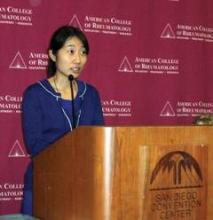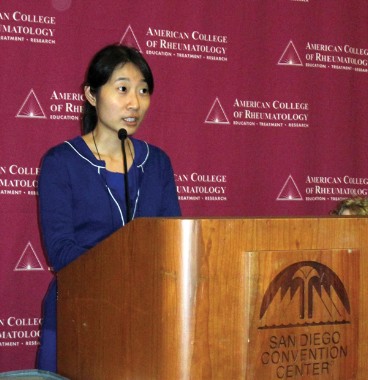User login
SAN DIEGO – Osteoarthritis patients who meet federal guidelines for exercise have more days of perfect health per year than do their sedentary counterparts, results from a novel study suggest.
"Our findings support interventions that help older adults to increase their physical activity level, even if guidelines are not fully met," Dr. Kai Sun said during a press briefing at the annual meeting of the American College of Rheumatology. "Increased physical activity could essentially translate into better quality of life and increased time spent in good health. We expect that this benefit would translate into lower overall health care costs."
Osteoarthritis is "a major cause of disability, and its prevalence is on the rise due to the aging population and the obesity epidemic. Inactivity is also a major problem in the United States. This is a significant economic burden as well because of the disability and the many health issues associated with inactivity as well as lost productivity and diminished quality of life," noted Dr. Sun, a medical resident and research trainee at Northwestern Feinberg School of Medicine, Chicago.
The study involved analysis of data from the National Institutes of Health–funded Osteoarthritis Initiative (OAI) to gather information on the physical activity levels of more than 4,700 adults, most of whom were aged older than 65 years and more than 40% of whom had a body mass index over 30 kg/m2, with or at risk for knee osteoarthritis.
The researchers set out to determine whether meeting the 2008 physical activity guidelines from the Department of Health and Human Services would translate into better overall quality of life and whether interventions to improve physical activity level correlate to better quality-adjusted life years (QALYs).The HHS guidelines recommend 150 minutes of moderate to vigorous activity per week performed in sessions lasting at least 10 minutes each. "An example of moderate activity would be walking briskly as if you were late to an appointment," Dr. Sun said.
The researchers used accelerometers to measure the physical activity level in 1,794 OAI study participants over the course of 1 week and placed them into one of three groups: 235 who met the HHS exercise guidelines of 150 minutes of moderate to vigorous activity, 763 who were "insufficiently active" (engaging in some but fewer than 150 minutes of moderate to vigorous exercise per week), and 796 who were inactive (engaging in no moderate to vigorous exercise per week). Health-related utility scores used to calculate QALYs were measured at the beginning of the study and 2 years later.
Overall, QALYs were significantly better with increasing level of physical activity, Dr. Sun reported. "This was a graded relationship, meaning that [people] in the middle group who had some [level of exercise] but not enough to meet guidelines had significantly better overall quality of life compared with the inactive group," she said. Specifically, after adjustment for socioeconomic and health factors over the 2-year period, people who met the HHS exercise guidelines had QALYs that were 0.11 higher compared with those who were inactive. At the same time, those in the insufficiently active group had QALYs that were 0.058 higher compared with those who were inactive.
"The most active group experienced the most benefit," Dr. Sun said. "The improvement was meaningful and translated into roughly an additional 10-20 days of perfect health in a year. We estimate that if an intervention could move someone out of the inactive group and cost less than $1,450 per person per year, that intervention would be considered cost-effective."
The researchers had no relevant financial conflicts to disclose.
SAN DIEGO – Osteoarthritis patients who meet federal guidelines for exercise have more days of perfect health per year than do their sedentary counterparts, results from a novel study suggest.
"Our findings support interventions that help older adults to increase their physical activity level, even if guidelines are not fully met," Dr. Kai Sun said during a press briefing at the annual meeting of the American College of Rheumatology. "Increased physical activity could essentially translate into better quality of life and increased time spent in good health. We expect that this benefit would translate into lower overall health care costs."
Osteoarthritis is "a major cause of disability, and its prevalence is on the rise due to the aging population and the obesity epidemic. Inactivity is also a major problem in the United States. This is a significant economic burden as well because of the disability and the many health issues associated with inactivity as well as lost productivity and diminished quality of life," noted Dr. Sun, a medical resident and research trainee at Northwestern Feinberg School of Medicine, Chicago.
The study involved analysis of data from the National Institutes of Health–funded Osteoarthritis Initiative (OAI) to gather information on the physical activity levels of more than 4,700 adults, most of whom were aged older than 65 years and more than 40% of whom had a body mass index over 30 kg/m2, with or at risk for knee osteoarthritis.
The researchers set out to determine whether meeting the 2008 physical activity guidelines from the Department of Health and Human Services would translate into better overall quality of life and whether interventions to improve physical activity level correlate to better quality-adjusted life years (QALYs).The HHS guidelines recommend 150 minutes of moderate to vigorous activity per week performed in sessions lasting at least 10 minutes each. "An example of moderate activity would be walking briskly as if you were late to an appointment," Dr. Sun said.
The researchers used accelerometers to measure the physical activity level in 1,794 OAI study participants over the course of 1 week and placed them into one of three groups: 235 who met the HHS exercise guidelines of 150 minutes of moderate to vigorous activity, 763 who were "insufficiently active" (engaging in some but fewer than 150 minutes of moderate to vigorous exercise per week), and 796 who were inactive (engaging in no moderate to vigorous exercise per week). Health-related utility scores used to calculate QALYs were measured at the beginning of the study and 2 years later.
Overall, QALYs were significantly better with increasing level of physical activity, Dr. Sun reported. "This was a graded relationship, meaning that [people] in the middle group who had some [level of exercise] but not enough to meet guidelines had significantly better overall quality of life compared with the inactive group," she said. Specifically, after adjustment for socioeconomic and health factors over the 2-year period, people who met the HHS exercise guidelines had QALYs that were 0.11 higher compared with those who were inactive. At the same time, those in the insufficiently active group had QALYs that were 0.058 higher compared with those who were inactive.
"The most active group experienced the most benefit," Dr. Sun said. "The improvement was meaningful and translated into roughly an additional 10-20 days of perfect health in a year. We estimate that if an intervention could move someone out of the inactive group and cost less than $1,450 per person per year, that intervention would be considered cost-effective."
The researchers had no relevant financial conflicts to disclose.
SAN DIEGO – Osteoarthritis patients who meet federal guidelines for exercise have more days of perfect health per year than do their sedentary counterparts, results from a novel study suggest.
"Our findings support interventions that help older adults to increase their physical activity level, even if guidelines are not fully met," Dr. Kai Sun said during a press briefing at the annual meeting of the American College of Rheumatology. "Increased physical activity could essentially translate into better quality of life and increased time spent in good health. We expect that this benefit would translate into lower overall health care costs."
Osteoarthritis is "a major cause of disability, and its prevalence is on the rise due to the aging population and the obesity epidemic. Inactivity is also a major problem in the United States. This is a significant economic burden as well because of the disability and the many health issues associated with inactivity as well as lost productivity and diminished quality of life," noted Dr. Sun, a medical resident and research trainee at Northwestern Feinberg School of Medicine, Chicago.
The study involved analysis of data from the National Institutes of Health–funded Osteoarthritis Initiative (OAI) to gather information on the physical activity levels of more than 4,700 adults, most of whom were aged older than 65 years and more than 40% of whom had a body mass index over 30 kg/m2, with or at risk for knee osteoarthritis.
The researchers set out to determine whether meeting the 2008 physical activity guidelines from the Department of Health and Human Services would translate into better overall quality of life and whether interventions to improve physical activity level correlate to better quality-adjusted life years (QALYs).The HHS guidelines recommend 150 minutes of moderate to vigorous activity per week performed in sessions lasting at least 10 minutes each. "An example of moderate activity would be walking briskly as if you were late to an appointment," Dr. Sun said.
The researchers used accelerometers to measure the physical activity level in 1,794 OAI study participants over the course of 1 week and placed them into one of three groups: 235 who met the HHS exercise guidelines of 150 minutes of moderate to vigorous activity, 763 who were "insufficiently active" (engaging in some but fewer than 150 minutes of moderate to vigorous exercise per week), and 796 who were inactive (engaging in no moderate to vigorous exercise per week). Health-related utility scores used to calculate QALYs were measured at the beginning of the study and 2 years later.
Overall, QALYs were significantly better with increasing level of physical activity, Dr. Sun reported. "This was a graded relationship, meaning that [people] in the middle group who had some [level of exercise] but not enough to meet guidelines had significantly better overall quality of life compared with the inactive group," she said. Specifically, after adjustment for socioeconomic and health factors over the 2-year period, people who met the HHS exercise guidelines had QALYs that were 0.11 higher compared with those who were inactive. At the same time, those in the insufficiently active group had QALYs that were 0.058 higher compared with those who were inactive.
"The most active group experienced the most benefit," Dr. Sun said. "The improvement was meaningful and translated into roughly an additional 10-20 days of perfect health in a year. We estimate that if an intervention could move someone out of the inactive group and cost less than $1,450 per person per year, that intervention would be considered cost-effective."
The researchers had no relevant financial conflicts to disclose.
AT THE ACR ANNUAL MEETING
Major finding: Over the course of 2 years, people with, or at risk for, osteoarthritis who met the HHS exercise guidelines for adults had quality-adjusted life years that that were 0.11 higher compared with those who were inactive.
Data source: A nationwide study of 1,794 participants in the National Institutes of Health–funded Osteoarthritis Initiative.
Disclosures: The researchers had no relevant financial conflicts to disclose.

